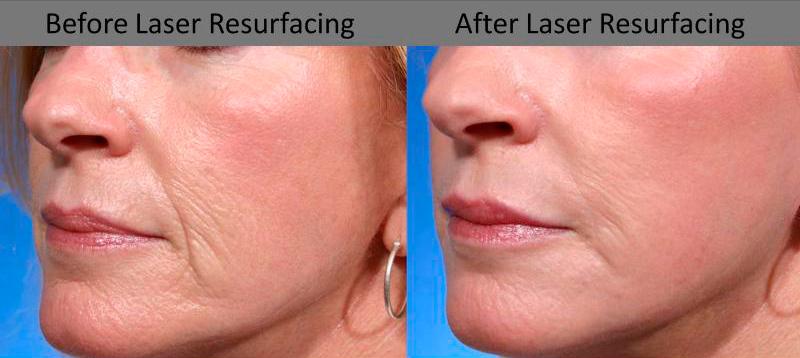
Before knowing the side effects of laser resurfacing, it is important to understand what the procedure is all about. Laser resurfacing, also known as lasabrasion, is a treatment done to correct skin flaws, including wrinkles, blemishes, and acne scars, by use of a laser. The procedure involves the removal of skin layers by directing concentrated pulsating light to the skin. Laser resurfacing can either be ablative or nonablative. While ablative laser involves wounding, nonablative laser is a non-wounding technique.
Laser resurfacing is used to treat various skin conditions, including scars, age spots, irregular skin texture or tone, and wrinkles. The procedure can also be applied to correct a damaged skin as a result of exposure to intense sun rays.
Side Effects of Laser Resurfacing
Although laser resurfacing enhances your skin appearance, the procedure may result in a number of side effects, which may vary with the type of laser used.
1. Ablative Laser
The side effects of ablative laser resurfacing include:
a) Acne
This may result from bandages and thick creams applied to your face following the resurfacing procedure. The creams and bandages can also result in white bumps or milia, which usually disappear after a few days.
b) Abnormal Skin Pigmentation
Ablative laser resurfacing may result in hyperpigmentation, a condition in which your skin turns abnormally dark. It can also cause hypopigmentation, a condition in which the skin appears lighter than normal. The good thing with these abnormalities is that they can easily be treated. Hyperpigmentation, for instance, can be treated by applying glycolic acid or topical retinoic acid after healing. Use of sunscreens during the healing process is also important. Hypopigmentation can be treated through nonablative fractional photothermolysis.
c) Infection
Since ablative laser resurfacing is a wounding procedure, it exposes your facial skin to infection from virus, bacterium, or fungus. Herpes virus flare-up is one of the most common infections caused by ablative laser resurfacing. Typically, you will experience cold sores if you are infected with herpes virus.
d) Ectropion
Ablative laser resurfacing may, in rare cases, result in ectropion, which refers to the turning out of the eyelids. Ectropion causes exposure of the inner surfaces of your eyelids. Surgery to treat ectropion is necessary.
e) Scarring and Itching
Ablative laser resurfacing may cause scarring and itching due to the wound created during the procedure. Typically, skin itching disappears on its own with time.
f) Swelling and Redness
The degree of redness depends on how deep the resurfacing is. While shallow resurfacing may cause mild redness, deeper resurfacing may result in serious redness that persists for several months.
g) Burns
Ablative laser resurfacing involves heat, which can cause skin burns.
2. Non Ablative Laser
Just like ablative laser resurfacing, non ablative procedure may cause herpes virus flare-ups. It may also cause hyperpigmentation among people with dark skins. Other possible side effects include scars, blisters, swelling, and redness.
Since laser resurfacing is not ideal for everyone, it is important to consult with your doctor before the procedure. The may not be a candidate of this procedure if you have one or more of the following:
- Excessively dark skin
- Scar formation tendency
- Acne
- Weak immune system or autoimmune disorder
What to Expect During the Procedure
The time taken to complete ablative skin resurfacing depends on the size of the skin that needs treatment and the technique your doctor will apply. Typically, the duration ranges from 30 minutes to two hours. During ablative laser resurfacing, your surgeon will administer an anesthetic to numb your skin. Sedation may be necessary if the procedure will involve correction of the entire face. The doctor will destroy your epidermis by directing an intense light beam at your skin while heating the dermis at the same time. The beam will shrink the collagen fibers of your skin and cause a wound, which will heal and cause your skin to become more smooth and tight.
During non ablative laser resurfacing, the surgeon will administer a topical anesthetic to numb your skin. An additional pain reliever may be necessary in case you have fractional photothermolysis. A water-based gel will be applied to protect your epidermis. The doctor will direct the laser at your skin to destroy the collagen fibers. New collagen will grow, resulting in a tight and improved skin texture. Nonablative treatment does not involve the removal of any part of your skin, and it takes 15 to 90 minutes. After the procedure, you can apply ice packs to relieve swelling. Since there is no downtime involved, you can go back to your daily routine immediately after the procedure.
Laser Resurfacing Results
In most cases, laser resurfacing yields positive results. Although the skin may turn pink or red for a few months, there will be noticeable sudden changes in the appearance and quality of your skin as soon as your face recovers from ablative laser resurfacing, and these changes may last for several years.
In non ablative laser resurfacing, the results are subtle and gradual. You skin will improve in pigmentation and texture. Since exposure to the sunlight may cause irregular skin pigmentation, you may be required to use sunscreens for about one year after the procedure. It is important to note that the results of laser resurfacing are not permanent. Due to aging and other factors, lines may still appear on your skin even after the procedure.
Bottom Line
Although laser resurfacing may cause side effects, most of the side effects can be avoided if the procedure is done by a qualified and experienced plastic surgeon. If you are seriously considering laser resurfacing, Dilworth Facial Plastic Surgery can offer an expert opinion and point you in the best direction to get the results you want to see. Visit Dr. Josh Surowitz and Dr. Andrea Garcia to learn more about your options!

Leave a Reply